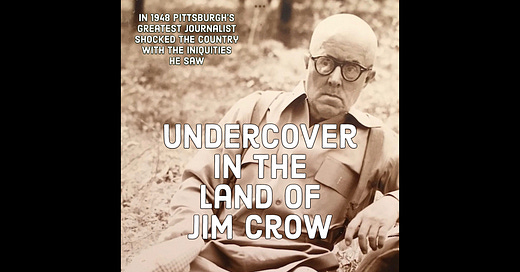Posing as a Black Man In The Jim Crow South
The Revealing Story of Pittsburgh Post Gazette Journalist Ray Sprigle
“I quit being white, and free, and an American citizen when I climbed aboard that Jim Crow coach. . . . From then on, until I came up out of the South four weeks later, I was black, and in bondage — not quite slavery but not quite freedom, either.”
Ray Sprigle
Pittsburgh born author and journalist Bill Steigerwald and I share many common interest. Last year I had the opportunity to feature his 2017 history book “30 Days a Black Man” on “Great Books, Great Minds.” where he retells the true story of Pittsburgh Post-Gazette star reporter Ray Sprigle's 1948 undercover, investigative reporting mission in the Jim Crow South.
Steigerwald’s book offers a sobering look at Sprigle's newspaper series, one that had huge implications on a nation that was deeply segregated in the North and South. This was in followup to Sprigle’s own book “Undercover in the Land of Jim Crow” based on his groundbreaking Post-Gazette series.
In 1948 most white Northerners had no comprehension of how egregiously unjust and unequal daily life was for the 10 million Black Americans living in the South. But that narrative was upended by Sprigle when as a famous white journalist from Pittsburgh, he went undercover and lived as a Black man in the Jim Crow South for a month.
With the blessing of the NAACP and its bold thinking executive secretary Walter White, John Wesley Dobbs, a historic black civil rights pioneer and political leader from Atlanta served as Sprigle’s host and protector during their meandering travels together throughout the South in 1948.
Boldly wanting to capture the lived experience of Black Americans under the oppressive and humiliating system of Jim Crow segregation, a heavily tanned Sprigle posed as a light-skinned NAACP field investigator from Pittsburgh, traversing the Deep South for a month.
Dobbs, who was 66 at the time, drove the uncommon duo from Savannah to the Mississippi Delta in a hulking ‘47 Mercury Eight. With Dobbs closely by his side, Sprigle visited with sharecroppers, local Black leaders, and families of lynching victims. He toured ramshackled Black schools and slept in the homes of prosperous Black farmers and doctors.
Sprigle later noted that the separate and unequal social, political and economic conditions he witnessed made him ashamed to be an American. His findings became fodder for his 21-part nationally syndicated newspaper series capturing his shocking experiences that stunned the White North, pissed off the White South and gave hope to millions of Blacks. It was the catalyst for the first national media debates about the future of legal segregation.
Called “ I Was a Negro in the South for 30 Days” Sprigle’s series was covered in both the Post-Gazette and in the nation’s largest Black weekly, the Pittsburgh Courier, the only Black newspaper that covered it. A number of other major papers like the New York Herald-Tribune and the Seattle Times began covering limited parts of the series under the title “In the Land of Crow.”
Steigerwald believes that Dobbs who he describes as a great political and social leader in the 1930s, 40s and 50s has never gotten the just recognition and publicity he deserves from modern day historians. The grandfather of Maynard Jackson Jr., the first black mayor of Atlanta, he considers Dobbs' travels with Sprigle to be his most daring and yet largely unknown accomplishment.
Sprigle's enterprising journalistic feat came six years before Brown v. Board of Education, seven years ahead of the murder of Emmett Till, and thirteen before John Howard Griffin’s similar experiment and bestseller 'Black Like Me.'
Concludes Steigerwald:
“Sprigle and Dobbs were both great and accomplished men in 1948. Dobbs' role was kept a secret from the public for decades. But Sprigle often said that he could never have pulled off his pioneering journalism without Dobbs’ help.”
Their unique collaboration deserves to be celebrated both during Black History Month and as part of America’s broader Black historical legacy.






